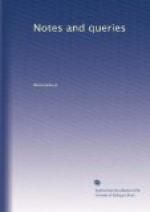C.
* * * * *
Pamphlets respecting Ireland (No. 24. p. 384.)—I would refer “I.” to No. 6161. in the Catalogue of Stowe Library, sold by Leigh Sotheby and Co., in January 1849. That lot consisted of two vols. of twenty-six tracts, 4to. Amongst them is “Gookin, the Author and Case of Transplanting the Irish in Connaught Vindicated, from Col. R. Lawrence, 1655.” Messrs. Leigh Sotheby will probably be able to inform the Querist into whose hands these two vols. passed. The lot sold for the large sum of 4l. 18s.
* * * * *
Pimlico (No. 24. p. 383.).—The derivation of this word is explained from the following passage in a rare (if not unique) tract now before me, entitled Newes from Hogsdon, 1598:—
“Have at thee, then,
my merrie boyes, and hey for old Ben
Pimlico’s nut-browne.”
Pimlico kept a place of entertainment in or near Hoxton, and was celebrated for his nut-brown ale. The place seems afterwards to have been called by his name, and is constantly mentioned by our early dramatists. In 1609 a tract was printed, entitled Pimlyco, or Runne Red Cap, ’tis a Mad World at Hogsdon. Isaac Reed (Dodsley’s Old Plays, ed. Collier, vii. 51.) says,—
“A place near Chelsea
is still called Pimlico, and was
resorted to within these few
years, on the same account as the
former at Hogsdon.”
Pimlico is still, I believe, celebrated for its fine ale.
EDWARD F. RIMBAULT.
* * * * *
Pimlico (No. 24. p. 383.).—I see, by a passage in Lord Orrery’s Letters, that there was a place called Pemlicoe in Dublin:—
“Brown is fluctuant;
he once lay at a woman’s house in
Pemlicoe, Dublin.” (Earl
of Orrery to Duke of Ormond, Feb.
5. 1663, in Orrery’s
State Letters.)
This may be of use to “R.H.,” who inquires about the origin of Pimlico. Ranelaugh, in the same parts, is doubtless also of Irish origin.
C.H.
[Pimlico in Dublin still exists,
as will be seen by reference
to Thom’s Irish Almanac,
where we find “Pimlico, from Coombe
to Tripoli.”]
* * * * *
Bive and Chute Lambs (No. 6. p. 93.).—I do not know whether my answer to your correspondent’s inquiry about bive and chute lambs will be satisfactory, inasmuch as the price he gives of “bive” lambs “apeece” is larger than the price of the “chute.” Twin lambs are still called bive lambs on the borders of Sussex and Kent; and chute lambs are fat lambs.
Chuet is an old word signifying a fat greasy pudding. It is rightly applied to Falstaff:—
“Peace, chewet, peace.”




